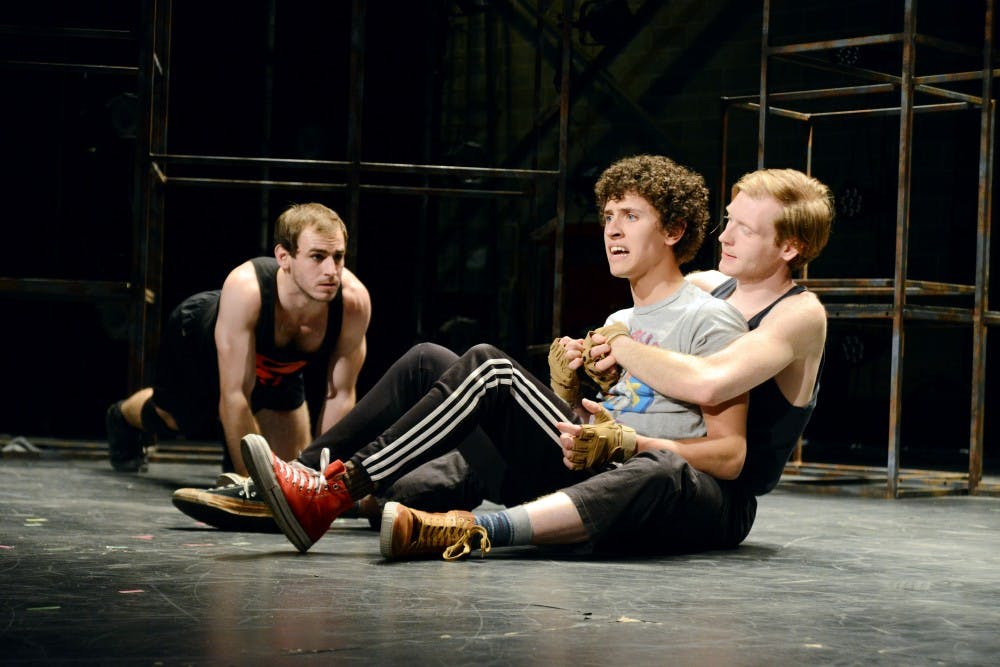What: Jungalbook
When: 7:30 p.m. Feb. 12-13 and 16-20, 2:30 p.m. Feb. 14 and 21
Where: University Theatre
Ticket Information:
Students: $12
General public: $15
Faculty/staff: $14
Senior citizens: $13
While many may be expecting "Jungalbook," part of this year's MainStage Series shows, to be like the Disney movie by the same name, this production is anything but. Apart from having a lot of the same character names, the Ball State theatre and dance department's production has more differences than similarities.
“It is a reimagining of the Mowgli stories that so many of us are aware of, but this play looks more at the relationships between those living in the jungle,” director Troy Dobosiewicz said.
Mowgli, played by junior musical theatre major Lincoln Clauss, is a “mancub” who has grown up in the jungle being raised by wolves. In this tale, the character is 10 years old and must face the challenges that come with growing up into a man, with the added struggles of not knowing he is a human in the first place.
“Even though everyone in the jungle keeps calling him a human, he doesn’t know what that is,” Clauss said. “He’s going through a stage of his life when he’s learning about the laws and dangers of the jungle and learning about feeling fear for the first time. All of a sudden, he realizes that the jungle isn’t the home he thought it was.”
Grey the wolf is played by sophomore acting major Justin Lee Vance, who describes his character as “in a constant struggle of listening to his pack leader Akela and what his animalistic instincts tell him what to do and how to behave.”
What drove the concept for this show was the concept of the “other” — the outsider or outcast.
“At various points in our lives, we are often ‘other' — when we move from one level of education to another, when we take on a new job, when we make new friends," Dobosiewicz said. "And that’s how the play speaks to me: it speaks to me about how Mowgli is forced to deal with the unfamiliar and the ‘other’ in his life, and we can all as human beings know what that feels like.”
The characters face challenges and choices to which audience members of all ages will be able to relate.
“Grey’s struggle of knowing where he belongs and what pecking order he fits is something that a lot of college students go through, that a lot of humans go through,” Vance said.
Many of the characters in this play are animals, and in order to prepare for these roles, the actors engaged in research about their animals in order to be as authentic as possible.
Sophomore musical theatre major Ivy Moody, who plays Sherakhan the tiger, said they did extensive research on the animals, including watching videos and copying their sounds.
“We would record ourselves doing the sounds and play them with the videos to see how close we could get to a roaring tiger or a howling wolf,” she said.
“The challenge of this piece has been development of a language of movement in which animals are present, but in that we can also be human beings,” movement director Jonathan Becker said.
The process of learning these kinds of movements was a much more physically demanding process than the actors anticipated.
“For this show specifically, I don’t think any of us understood the physicality that this show would require,” Vance said. “These animal movements had to be blindingly specific in order to portray what we were trying to portray accurately.”
Part of the show’s environment is a large, welded jungle gym, which has presented the actors with an additional challenge — they had to rehearse without the set for the majority of the rehearsal process.
“This was a serious challenge because the set dictates to us what the staging was and what the quality of movement eventually became,” Becker said. “It is a character in the play that we have to interact with and the motivator for the movement for the play.”
In addition to having to adjust to using this part of the set, certain actors have faced the added physical demands of using it too. Clauss, for example, spends the majority of the show hanging from the jungle gym.
“I think I’m the cast member who spends the most time up there,” he said. “I had to choreograph and navigate my way through it, which was especially challenging before we had it, and then we had to readjust once we got here.”
In order to tell this story, the production team is utilizing a vast variety of theatrical arts, including sound, haze, a welded set with multiple levels, a shadow play and a total of 276 lights.
“We had to borrow lights from [John R.] Emens [Auditorium] for this to even take place,” Dobosiewicz said.
Overall, the production team has been working to create what Becker calls “an environment that is at once urban and jungle, a world in which we see one struggle with being different and having to go out into the world on one’s own to define one’s self.”
The show will run at 7:30 p.m. Feb. 12-13 and 16-20 and at 2:30 p.m. Feb. 14 and 21.
|
What: Jungalbook When: Feb. 12 and 13 at 7:30 p.m., Feb. 14 at 2:30 p.m., Feb. 16-20 at 7:30 pm and Feb. 21 at 2:30 p.m. Where: University Theatre Tickets Information: Students $12 General Public $15 Faculty/Staff $14 Senior Citizens $13 |





